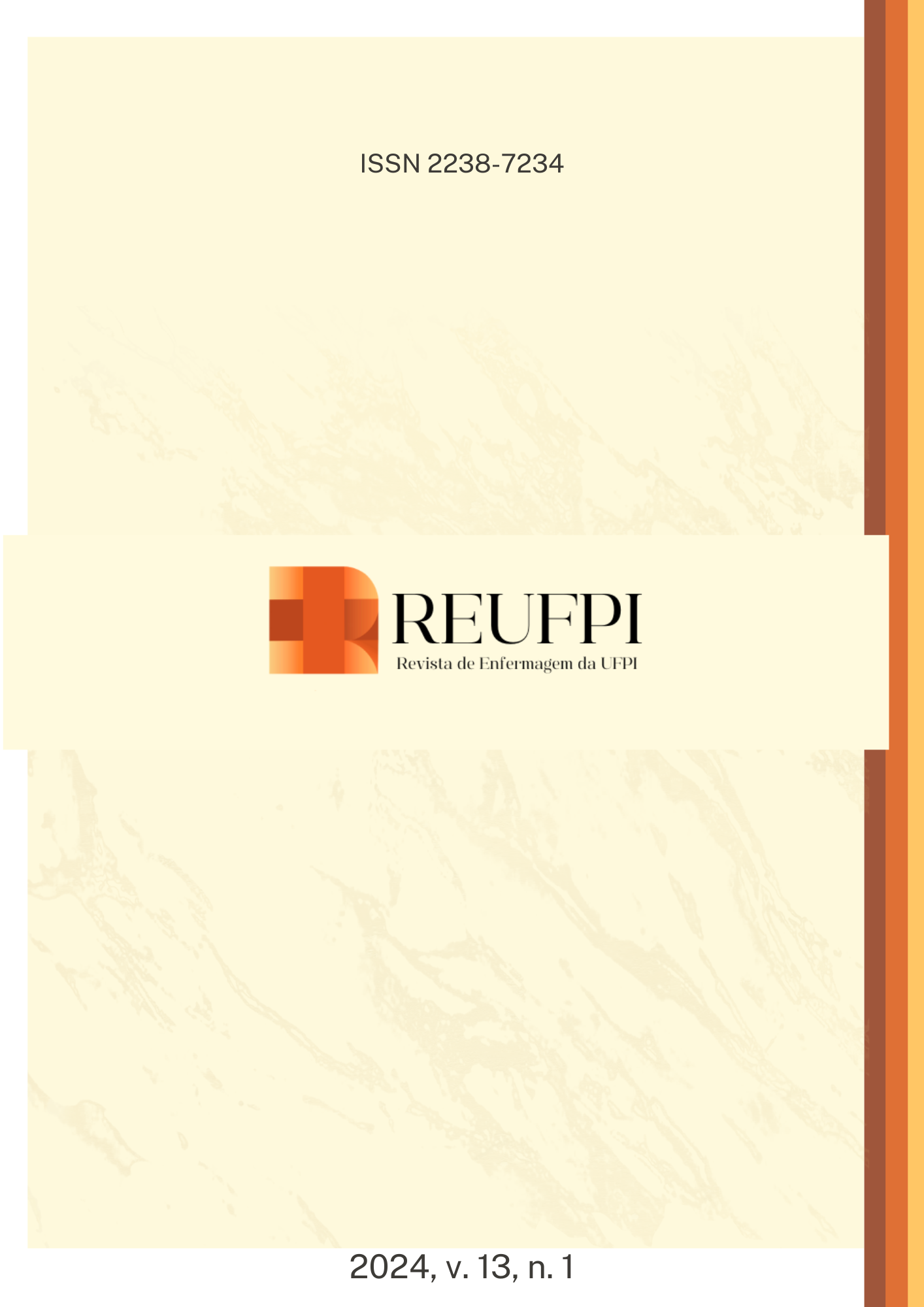Characteristics of self-medication assessment instruments in Brazil: an integrative review
DOI:
https://doi.org/10.26694/reufpi.v13i1.4095Keywords:
Brazil, Self Medication, Psychometrics, Validation StudyAbstract
Objective: To describe the characteristics of self-medication assessment instruments with evidence of validity in Brazil. Methods: An integrative review, without temporal delimitation, with collection in the LILACS, Scopus, PubMed, MEDLINE and Web of Science databases. Ten studies related to five instruments were included. Results: The most convergent domains were sociodemographic aspects, self-medication practice, reasons, medications used and recommendation/sources. Self-medication was assessed by only one instrument with evidence of validity, but it was multidimensional, making its application difficult. The instruments showed good reliability indices, however, of the five, one did not measure reliability. The good psychometric properties of the self-medication and temporomandibular pain instrument stand out (Kappa: 0.810, Cronbach’s alpha: 0.844). Conclusion: The different instruments analyzed present limitations in evidence of validity, showing the need to develop an instrument focused on self-medication that is reliable and valid.
References
World Health Organization (WHO). Guidelines for the regulatory assessment of medicinal products for use in self-medication. Geneva: WHO; 2000 [cited 2022 Jan 25]. Available from: https://apps.who.int/iris/handle/10665/66154
Almeida GO, Aidar FJ, Matos DG, Almeida-Neto PF, Melo EV, Barreto Filho JAS, et al. Non-targeted self-measurement of blood pressure: association with self-medication, unscheduled emergency visits and anxiety. Medicina (Kaunas). [Internet]. 2021;57(1):75. doi: https://doi.org/10.3390/medicina57010075
Jerez-Roig J, Medeiros LFB, Silva VAB, Bezerra CLPAM, Cavalcante LAR, Piuvezam G, et al. Prevalence of self-medication and associated factors in an elderly population: a systematic review. Drugs Aging [Internet]. 2014;31(12):883-96. doi: https://doi.org/10.1007/s40266-014-0217-x
Souza RCO, Andrade LG. Self-medication: pharmacist's performance in the prevention of drug poisoning. Revista Ibero-Americana de Humanidades, Ciências e Educação. [Internet]. 2021;7(10). doi: https://doi.org/10.51891/rease.v7i10.2634
Arrais PSD, Fernandes MEP, Pizzol TSD, Ramos LR, Mengue SS, Luiza VL, et al. Prevalence of self-medication in Brazil and associated factors. Rev Saúde Pública (Online). [Internet]. 2016;50(suppl 2). doi: https://doi.org/10.1590/S1518-8787.2016050006117
Instituto de Ciência, Tecnologia e Qualidade (ITCQ) [Internet]. Anápolis (GO): ITCQ; c2018 [cited 2022 May 20]. Pesquisa – Automedicação no Brasil. Available from: https://ictq.com.br/pesquisa-do-ictq/871-pesquisa-automedicacao-no-brasil-2018
Ahmad S, Babar MS, Essar MY, Sinha M, Nadkar A. Infodemic, self-medication and stockpiling: a worrying combination. East Mediterr Health J. [Internet]. 2021 [cited 2022 May 20];27(5):438-40. Available from: https://apps.who.int/iris/handle/10665/352808
Souza AC, Alexandre NMC, Guirardello EB. Psychometric properties in instruments evaluation of reliability and validity. Epidemiol Serv Saúde (Online). [Internet]. 2017;26(3):649-59. doi: https://doi.org/10.5123/S1679-49742017000300022
Souza MT, Silva MD, Carvalho R. Integrative review: what is it? How to do it? Einstein (São Paulo). [Internet]. 2010;18(1):102-6. doi: https://doi.org/10.1590/s1679-45082010rw1134
Henriksen K, Battles JB, Marks ES, Lewin DI, editors. Advances in patient safety: from research to implementation, vol. 4. Rockville: Agency for Healthcare Research and Quality; 2005.
Vasconcelos CMC, Sampaio HA, Vergara CM. Materiais educativos para prevenção e controle de doenças crônicas: uma avaliação à luz dos pressupostos do letramento em saúde. Curitiba (PR): Editora CRV; 2018.
Aquino DS, Barros JAC, Silva MDP. A automedicação e os acadêmicos da área de saúde. Cien Saude Colet. [Internet]. 2010;15(5):2533-8. doi: https://doi.org/10.1590/s1413-81232010000500027
Sousa LAO, Fonteles MMF, Monteiro MP, Mengue SS, Bertoldi AD, Dal Pizzol TS, et al. Prevalence and characteristics of adverse drug events in Brazil. Cad Saúde Pública. [Internet]. 2018;34(4). doi: https://doi.org/10.1590/0102-311X00040017
Dias IM, Bastos RR, Alves RT, Leite ICG. Construction and validation of a questionnaire for evaluating self-medication practised by patients with temporomandibular disorders. J Oral Rehabil. [Internet]. 2019;46(5):424-32. doi: https://doi.org/10.1111/joor.12764
Gonzaga CE, Kotze PG, Olandoski M. Prevalence of self-medication for dyspeptic symptoms in primary care: a brazilian survey. Arq Gastroenterol. (Online). [Internet]. 2021;58(3):364-9. doi: https://doi.org/10.1590/S0004-2803.202100000-61
Loyola Filho AI, Uchoa E, Firmo JO, Lima-Costa MF. Estudo de base populacional sobre o consumo de medicamentos entre idosos: Projeto Bambuí. Cad Saúde Pública. [Internet]. 2005;21(2):545-53. doi: https://doi.org/10.1590/s0102-311x2005000200021
Loyola Filho AI, Uchoa E, Guerra HL, Firmo JO, Lima-Costa MF. Prevalência e fatores associados à automedicação: resultados do projeto Bambuí. Rev Saúde Pública (Online). [Internet]. 2002;36(1):55-62. doi: https://doi.org/10.1590/S0034-89102002000100009
Moreira TA, Alvares-Teodoro J, Barbosa MM, Guerra Júnior AA, Acurcio FA. Use of medicines by adults in primary care: Survey on health services in Minas Gerais, Brazil. Rev Bras Epidemiol. [Internet]. 2020;23:e200025. doi: https://doi.org/10.1590/1980-549720200025
Pereira G, Surita FG, Ferracini AC, Madeira CS, Oliveira LS, Mazzola PG. Corrigendum: self-medication among pregnant women: prevalence and associated factors. Front Pharmacol. [Internet]. 2021;12:810762. doi: https://doi.org/10.3389/fphar.2021.810762
Pons ES, Knauth DR, Vigo A, PNAUM Research Group, Mengue SS. Predisposing factors to the practice of self-medication in Brazil: Results from the National Survey on Access, Use and Promotion of Rational Use of Medicines (PNAUM). PLoS ONE. [Internet]. 2017;12(12): e0189098. doi: https://doi.org/10.1371/journal.pone.0189098
Pasquali L. Testes referentes a Construto: teoria e modelo de construção. In: Luiz Pasquali L, editor. Instrumentação Psicológica: fundamentos e práticas. Porto Alegre (RS): Artmed; 2010. p. 165-98.
Temoteo RCA, Silva JAS, Oliveira SS, Sales JRP, Fernandes MC, Carvalho JBL. Contribuições dos enfermeiros no processo de adesão ao tratamento da tuberculose. Rev Enferm UFPI. [Internet]. 2023 [citado em 09 nov 2023];12:e3640. doi: https://doi.org/10.26694/reufpi.v12i1.3640.
Menezes AS, Bonanni IA, Souza MSGC, Carneiro SVG, Alves SM, Oliveira TA, et al. The self-medication in the world population: an integrative review. Res, Soc Develop. 2021;10(10):e125101018660. doi: https://doi.org/10.33448/rsd-v10i10.18660
Sørensen K. Uma visão para a literacia em saúde na Europa. In: Lopes C, Almeida CV, coordenadores. Lisboa: Edições ISPA; 2019. p. 27-32.
Nesari M, Olson JK, Nasrabadi AN, Norris C. Registered Nurses’ knowledge of and experience with health literacy. Health Lit Res Pract. 2019;3(4):e268-e279. doi: https://doi.org/10.3928/24748307-20191021-01
Pantuzza LLN, Nascimento E, Botelho SF, Martins MAP, Veloso RCSG, Nascimento MMG, et al. Mapping the construct and measurement of medication literacy: A scoping review. Br J Clin Pharmacol. 2021;87(3):754-775. doi: https://doi.org/10.1111/bcp.14491
Annisa M, Kristina SA. Self-medication practice, literacy and associated factors among university students in Yogyakarta. Int J Pharm Res. 2020;12(3):649-656. doi: https://doi.org/10.31838/ijpr/2020.12.03.098
Mostafa A, Abdelzaher A, Rashed S, AlKhawaga SI, Afifi SK, AbdelAlim S, et al. Is health literacy associated with antibiotic use, knowledge and awareness of antimicrobial resistance among non-medical university students in Egypt? A cross-sectional study. BMJ Open. 2021;11(3). doi: https://doi.org/10.1136/bmjopen-2020-044488
Alexandre NMC, Coluci MZO. Validade de conteúdo nos processos de construção e adaptação de instrumentos de medidas. Ciênc Saúde Coletiva [Internet]. 2011;16(7):3061–8. doi: https://doi.org/10.1590/S1413-81232011000800006
Costa MFL, Uchoa E, Guerra HL, Firmo JOA, Vidigal PG, Barreto SM. The Bambuí health and ageing study (BHAS): methodological approach and preliminary results of a population-based cohort study of the elderly in Brazil. Rev Saúde Pública (Online). [Internet]. 2000;34(2):126-35. doi: https://doi.org/10.1590/S0034-89102000000200005
Mengue SS, Bertoldi AD, Boing AC, Tavares NUL, Dal Pizzol TS, Oliveira MA, et al. National survey on access, use and promotion of rational use of medicines (PNAUM): household survey component methods. Rev Saúde Pública (Online). [Internet]. 2016;50(suppl 2):4s. doi: https://doi.org/10.1590/S1518-8787.2016050006156
Terwee CB, Bot SDM, Boer MR, van der Windt DAWM, Knol DL, Dekker J, et al. Quality criteria were proposed for measurement properties of health status questionnaires. J Clin Epidemiol. [Internet]. 2007;60(1):34-42. doi: https://doi.org/10.1016/j.jclinepi.2006.03.012
Molento MB. COVID-19 and the rush for self-medication and self-dosing with ivermectin: A word of caution. One Health. 2020;10. doi: https://doi.org/10.1016/j.onehlt.2020.100148
Alonso-Castro AJ, Ruiz-Padilla AJ, Ortiz-Cortes M, Carranza E, Ramírez-Morales MA, Escutia-Gutiérrez R, et al. Self-treatment and adverse reactions with herbal products for treating symptoms associated with anxiety and depression in adults from the central-western region of Mexico during the Covid-19 pandemic. J Ethnopharmacol. [Internet]. 2021;23(272):113952. doi: https://doi.org/10.1016/j.jep.2021.113952
Fundação Oswaldo Cruz. Sistema Nacional de Informações Tóxico-Farmacológicas [Internet]. Brasília: Fundação Oswaldo Cruz; c2023 [citado em 09 nov 2023]. Dados de intoxicação. Available from: https://sinitox.icict.fiocruz.br/dados-de-agentes-toxicos
Downloads
Published
How to Cite
Issue
Section
License
Copyright (c) 2024 Rev Enferm UFPI

This work is licensed under a Creative Commons Attribution 4.0 International License.
Autores mantém os direitos autorais e concedem à REUFPI o direito de primeira publicação, com o trabalho licenciado sob a Licença Creative Commons Attibution BY 4.0 que permite o compartilhamento do trabalho com reconhecimento da autoria e publicação inicial nesta revista.






